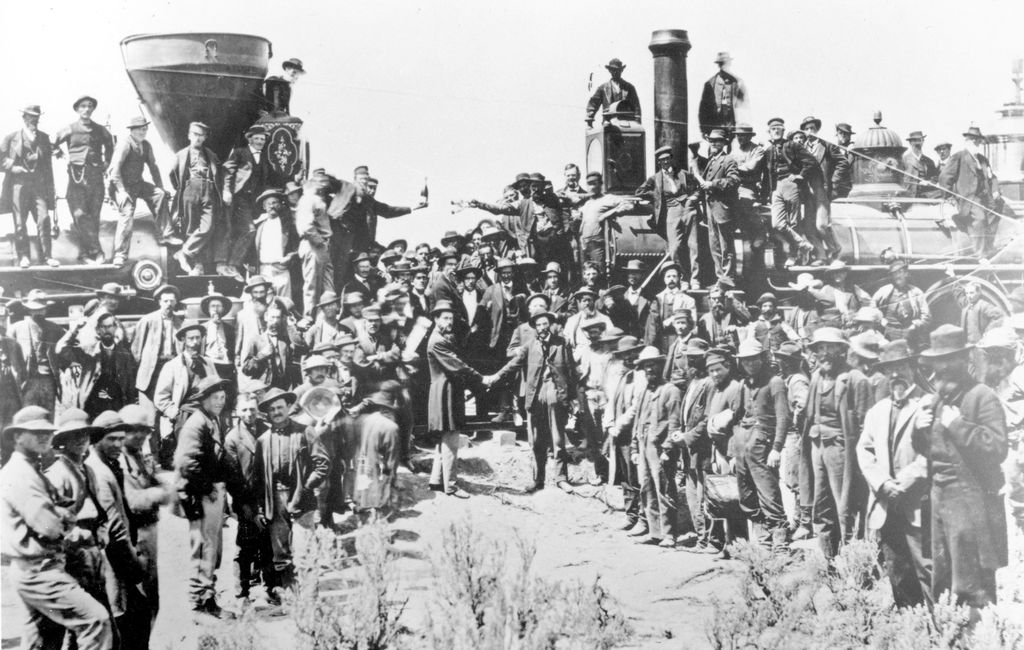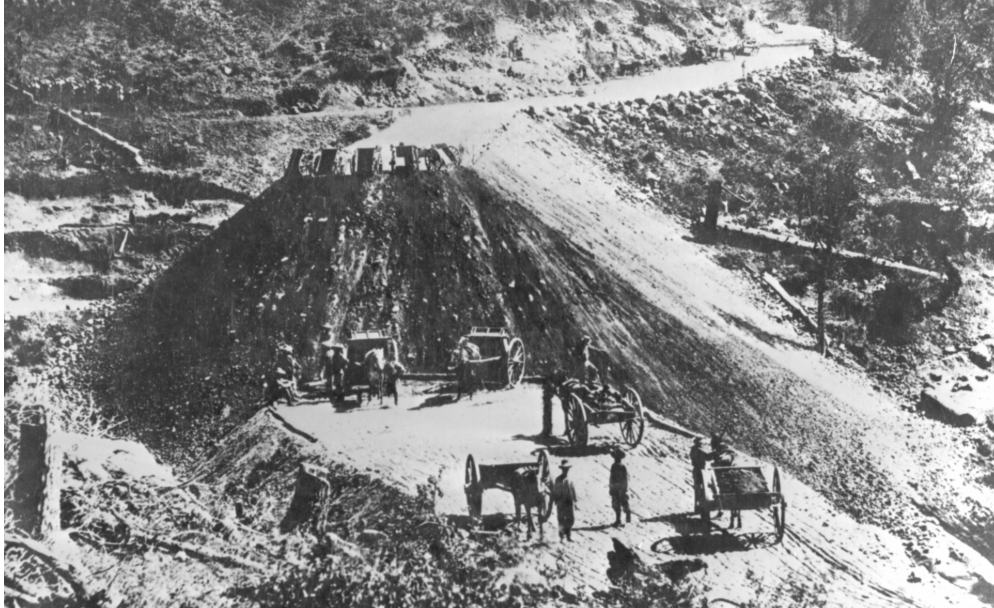The nation’s first transcontinental railroad was completed at Promontory, Utah. On May 10, 1869, a team of Chinese workers for the Central Pacific Railroad and a team of Irish workers for the Union Pacific Railroad lined up the final rails and support timbers.
In Short
Officials from the two railroad companies drove four ceremonial spikes into the rails to join the two lines together. Officials gave speeches and a famous photograph captured a few of the people who were there. The arrival of the railroad was historic for the nation and for Utah.

More of the Story
By the time of the Civil War, railroad networks already existed in the East, South, and Midwest. The transcontinental railroad was the first rail line that allowed goods and people to move all the way between the Atlantic and the Pacific coast entirely by train. It compressed a wagon journey that took over a month into just six days. The railroad paved the way for more immigration, more businesses, and more industrialization across the West.
1,500 miles
In 1862 the US Congress passed the Pacific Railway Act, and President Abraham Lincoln signed it. Two railroad companies took part in the project. The Central Pacific began from Sacramento, California, building eastward across the Sierra Nevada mountains and Nevada. The Union Pacific started from Omaha, Nebraska, and built westward across the Great Plains and Wyoming. Using mule teams, explosives, shovels, picks, and hammers, workers crept toward each other over 1,500 long miles.
The massive project depended on the hard work of poorly paid laborers, most of whom were immigrants from Asia and Europe. The Central Pacific recruited thousands of workers from southern China. The Chinese railroad workers were the backbone of the Central Pacific labor force. The Union Pacific employed Irish workers driven from Ireland by rampant starvation and disease. The railroads also hired Civil War veterans, freed slaves, and Latter-day Saint settlers to meet their labor needs.

Engines of Change
The transcontinental railroad launched Utah’s railroad age and ushered in a time of great change for Utah’s existing Indigenous and settler communities.
Soon after the transcontinental railroad opened, new rail lines connected Ogden to Salt Lake City. From there, lines connected Salt Lake City to mining areas like Alta and Park City. Mining became a major industry in the state, because railroads could carry the ore to distant markets. Rail lines to places like Price, Helper, and Castle Gate helped Utah’s mining districts grow. Many other jobs were tied to the railroad as well. Many workers were needed to repair track, handle baggage, and assist passengers.
The railroad made it easier and faster to ship goods, which allowed Utah’s farmers to sell their crops to more distant markets without spoiling. Trade grew throughout the state and attracted more people and new businesses. Utah’s growth attracted thousands of immigrants and their families, who came from all over the world.

Before 1869, 91 percent of EuroAmericans in Utah were members of the Church of Jesus Christ of Latter-day Saints (Mormons). However, after the arrival of the railroads, the population began to shift. By 1890, Mormons made up 66 percent of Utah’s population, or just over half. Many immigrants came from European countries like Italy, Greece, Finland, and Great Britain. Some came in hopes of finding mineral wealth in Utah’s mining areas. Others came to join the LDS community. Immigrant settlers came from many different ethnic and religious backgrounds and made Utah a more diverse place.
The rapid growth of settlement and industrialization in Utah created huge challenges for Shoshone, Ute, Goshute, Paiute, and Navajo communities. These peoples had lived in Utah for many hundreds of years before settlement began in the 1800s. However, immigrant settlers claimed vital resources–especially the fertile lands near water–that Indigenous people relied upon for food. Native communities began to starve. The federal government worked to take control of Native lands and move Native peoples away from settled areas. Two isolated reservations were designated for Ute and Navajo peoples, and other small reservations followed. The tribes worked for many years to respond to these challenges, to assert their sovereignty (political identity), and preserve their cultures and families.
Keep Exploring!
Return to the Immigration and Expansion page here.
Return to the I love Utah History home page here.